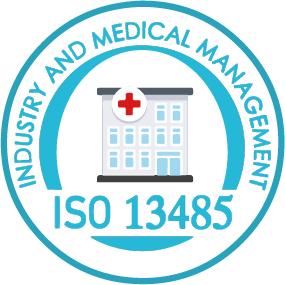Call Us: +201000223355
ISO 13485:2016
ISO 13485:2016 specifies the requirements for a quality management system where an organization needs to demonstrate its ability to provide medical devices and related services that consistently meet customer and applicable regulatory requirements. The primary objective of the standard is to facilitate harmonized medical device regulatory requirements for quality management systems.

What is ISO 13485:2016?
ISO 13485:2016 specifies the requirements for a quality management system where an organization needs to demonstrate its ability to provide medical devices and related services that consistently meet customer and applicable regulatory requirements. The primary objective of the standard is to facilitate harmonized medical device regulatory requirements for quality management systems.
Key Features of ISO 13485:2016:
-
Risk Management: Emphasizes a risk-based approach to the development, manufacture, and lifecycle of medical devices, ensuring that risks are identified, assessed, and mitigated effectively.
-
Regulatory Compliance: The standard requires organizations to comply with regulatory requirements applicable to the safety and performance of medical devices.
-
Documentation: Detailed documentation and record-keeping are critical, including maintaining a quality manual, procedures, and records to ensure traceability and accountability.
-
Process Control: Focuses on the control of processes, including design and development, production, storage, distribution, installation, and servicing of medical devices.
-
Product Realization: Ensures that products are planned, developed, and manufactured in a controlled manner to meet specified requirements.
-
Corrective and Preventive Actions: Requires organizations to establish processes for identifying and correcting non-conformities and implementing preventive actions to avoid recurrence.
-
Supplier Management: Emphasizes the importance of controlling and managing suppliers to ensure that procured products and services meet specified requirements.
-
Customer Focus: Ensures that customer requirements are understood and consistently met, enhancing customer satisfaction.
-
Continual Improvement: Encourages ongoing improvement of the QMS to enhance performance and ensure the highest quality of medical devices.
Benefits of ISO 13485:2016 Certification:
- Improved Quality and Safety: Helps organizations ensure that medical devices are safe and effective for their intended use.
- Regulatory Compliance: Facilitates compliance with regulatory requirements, reducing the risk of legal issues and enhancing market access.
- Market Access: ISO 13485:2016 certification is often a prerequisite for entering and operating in various global markets.
- Customer Confidence: Demonstrates a commitment to quality and safety, building trust and confidence among customers and stakeholders.
- Operational Efficiency: Streamlined processes and effective risk management lead to increased operational efficiency and reduced costs.
- Supplier Management: Ensures that suppliers meet quality requirements, contributing to the overall quality of the final product.
- Continual Improvement: Fosters a culture of continuous improvement, helping organizations enhance their processes and products over time.
ISO 13485:2016 is a critical standard for organizations involved in the medical device industry. It provides a comprehensive framework for establishing and maintaining a quality management system that ensures the safety and effectiveness of medical devices. Achieving ISO 13485:2016 certification demonstrates a commitment to quality and regulatory compliance, enhancing trust and confidence among customers and stakeholders. By adopting ISO 13485:2016, organizations can improve their operational efficiency, ensure regulatory compliance, and deliver high-quality medical devices that meet the needs of healthcare providers and patients.